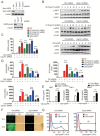USP3 inhibits type I interferon signaling by deubiquitinating RIG-I-like receptors
- PMID: 24366338
- PMCID: PMC3975496
- DOI: 10.1038/cr.2013.170
USP3 inhibits type I interferon signaling by deubiquitinating RIG-I-like receptors
Abstract
Lysine 63 (K63)-linked ubiquitination of RIG-I plays a critical role in the activation of type I interferon pathway, yet the molecular mechanism responsible for its deubiquitination is still poorly understood. Here we report that the deubiquitination enzyme ubiquitin-specific protease 3 (USP3) negatively regulates the activation of type I interferon signaling by targeting RIG-I. Knockdown of USP3 specifically enhanced K63-linked ubiquitination of RIG-I, upregulated the phosphorylation of IRF3 and augmented the production of type I interferon cytokines and antiviral immunity. We further show that there is no interaction between USP3 and RIG-I-like receptors (RLRs) in unstimulated or uninfected cells, but upon viral infection or ligand stimulation, USP3 binds to the caspase activation recruitment domain of RLRs and then cleaves polyubiquitin chains through cooperation of its zinc-finger Ub-binding domain and USP catalytic domains. Mutation analysis reveals that binding of USP3 to polyubiquitin chains on RIG-I is a prerequisite step for its cleavage of polyubiquitin chains. Our findings identify a previously unrecognized role of USP3 in RIG-I activation and provide insights into the mechanisms by which USP3 inhibits RIG-I signaling and antiviral immunity.
Figures







Similar articles
-
Ubiquitin-specific Protease 15 Negatively Regulates Virus-induced Type I Interferon Signaling via Catalytically-dependent and -independent Mechanisms.Sci Rep. 2015 Jun 10;5:11220. doi: 10.1038/srep11220. Sci Rep. 2015. PMID: 26061460 Free PMC article.
-
Activation of duck RIG-I by TRIM25 is independent of anchored ubiquitin.PLoS One. 2014 Jan 23;9(1):e86968. doi: 10.1371/journal.pone.0086968. eCollection 2014. PLoS One. 2014. PMID: 24466302 Free PMC article.
-
Ubiquitin-induced oligomerization of the RNA sensors RIG-I and MDA5 activates antiviral innate immune response.Immunity. 2012 Jun 29;36(6):959-73. doi: 10.1016/j.immuni.2012.03.022. Epub 2012 Jun 14. Immunity. 2012. PMID: 22705106 Free PMC article.
-
Recent Advances and Contradictions in the Study of the Individual Roles of Ubiquitin Ligases That Regulate RIG-I-Like Receptor-Mediated Antiviral Innate Immune Responses.Front Immunol. 2020 Jun 24;11:1296. doi: 10.3389/fimmu.2020.01296. eCollection 2020. Front Immunol. 2020. PMID: 32670286 Free PMC article. Review.
-
Ubiquitin-mediated modulation of the cytoplasmic viral RNA sensor RIG-I.J Biochem. 2012 Jan;151(1):5-11. doi: 10.1093/jb/mvr111. Epub 2011 Sep 2. J Biochem. 2012. PMID: 21890623 Review.
Cited by
-
Deubiquitinating Enzyme USP21 Inhibits HIV-1 Replication by Downregulating Tat Expression.J Virol. 2021 Jun 10;95(13):e0046021. doi: 10.1128/JVI.00460-21. Epub 2021 Jun 10. J Virol. 2021. PMID: 33827943 Free PMC article.
-
Role of Virally-Encoded Deubiquitinating Enzymes in Regulation of the Virus Life Cycle.Int J Mol Sci. 2021 Apr 23;22(9):4438. doi: 10.3390/ijms22094438. Int J Mol Sci. 2021. PMID: 33922750 Free PMC article. Review.
-
Innate immune responses to RNA: sensing and signaling.Front Immunol. 2024 Jan 25;15:1287940. doi: 10.3389/fimmu.2024.1287940. eCollection 2024. Front Immunol. 2024. PMID: 38343534 Free PMC article. Review.
-
USP19 modulates autophagy and antiviral immune responses by deubiquitinating Beclin-1.EMBO J. 2016 Apr 15;35(8):866-80. doi: 10.15252/embj.201593596. Epub 2016 Mar 17. EMBO J. 2016. PMID: 26988033 Free PMC article.
-
Post-translational Control of Intracellular Pathogen Sensing Pathways.Trends Immunol. 2017 Jan;38(1):39-52. doi: 10.1016/j.it.2016.10.008. Epub 2016 Nov 15. Trends Immunol. 2017. PMID: 27863906 Free PMC article. Review.
References
Publication types
MeSH terms
Substances
Grants and funding
LinkOut - more resources
Full Text Sources
Other Literature Sources
Molecular Biology Databases
Research Materials

